Apocrypha to canon: inventing Irish Traveller history*
Published in 20th-century / Contemporary History, Features, Issue 4 (Winter 2004), Volume 12![Detail of A Gypsy [sic] Encampment (1810) by William Mulready—evidence that the tent was not introduced into Ireland in the 1870s, as claimed by the Gmelches. (National Gallery of Ireland)](https://www.historyireland.com/wp-content/uploads/2013/02/70_small_12475759591.jpg)
Detail of A Gypsy [sic] Encampment (1810) by William Mulready—evidence that the tent was not introduced into Ireland in the 1870s, as claimed by the Gmelches. (National Gallery of Ireland)
(Nusight, Poverty in Ireland, November 1969)
IIn 1952 the Irish Folklore Commission sent out a questionnaire covering a range of Traveller-related topics—typical occupations and surnames, community relations and so on—to schoolteachers all over the Republic, who passed it on to their pupils, who passed it on to their parents and reported back. It is thus an invaluable record of grass-roots Irish opinion at the time. Responses to the question on Traveller origins varied wildly, from ‘descendants of old Irish metal workers scattered after the break-up of Irish society in the seventeenth century’ or ‘the descendants of [Irish] princes and kings’ to ‘the lost children of Israel’. Many respondents stressed the continuity between Travellers here and elsewhere: for example, ‘The tinkers or gypsies are said to have come from Egypt away back in prehistoric times and to have led a roving life ever since’. And again: ‘The Hungarian Gipsy groups are regarded as the core or centre of all Gipsy groups today. Probably they and the early tribes who invaded Ireland were of one origin and therefore the present-day Tinkers and Gipsies are as one the world over.’ On the other hand, quite a lot of respondents simply said they had no idea: ‘Nobody here is so interested as to think of them at all’, though this was often in a context stressing historical continuity; as one man put it, ‘Nothing to say under this head except that the Travellers have always been coming and going through Croom’. The respondent then repeated, and underlined, the word ‘Always’.
Half a century ago, then, there was no popular consensus as to the origin of Irish Travellers except that it was lost in the mists of time. Nor was there agreement on how they fitted into the ‘big picture’ of travelling people worldwide. If a similar survey was held today there would be no such confusion: it is now commonly understood that Irish Travellers, entirely unrelated to ‘real Gypsies’, are descended from Irish peasants forced onto the roads, most significantly as a result of the Great Famine of the 1840s. Yet virtually no historical research has been carried out in the interim, so how did this particular alternative come to replace all the others?
‘Resettlement’ and ‘rehabilitation’?
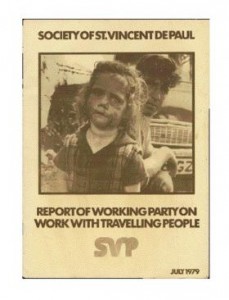
The 1963 report of the Commission on Itinerancy defined Travellers as drop-outs to be ‘rehabilitated’ and ‘re-absorbed’, inspiring a flurry of well-intentioned intervention. (Society of St Vincent de Paul)
Only a decade after the folklore questionnaire, the Commission on Itinerancy, set up to ‘promote [itinerants’] absorption into the general community’ and which by its own admission carried out ‘no special study of the origins of the itinerant population of this country’, began its report by summarising popular origin theories, including that concerning Famine victims, drawing particular attention to the claim by ten per cent of the parents of Traveller families that their parents in turn had been ‘settled’. Although the authors add that many of these turned out to be itinerants who owned houses, the implication was clear: one in ten Travellers were no more than two generations removed from ordinary house-dwelling society, with the further implication that bringing them back in—referred to in the 1960s as their ‘resettlement’ and ‘rehabilitation’—was not only morally justified but relatively straightforward.
It was nearly a decade before this politically expedient version of ‘where Travellers came from’ was fleshed out, in a thesis for a master’s in social work tellingly entitled Itinerancy and poverty, a premise since formally renounced by the author, Patricia McCarthy. Because it comprised the first-ever fieldwork undertaken with Travellers, ‘scientifically’ confirming their conformity to virtually every characteristic on the then-fashionable ‘culture of poverty’ checklist, it was enthusiastically promoted by the Itinerant Settlement Committee set up to implement the recommendations of the Commission, who mimeographed it and sold it at cost price, bypassing publication. As a result, and despite its profound impact in Ireland, it is virtually unknown abroad, yet, via published American academics George and Sharon Gmelch, who drew their inspiration from it, it indirectly shaped the paradigm worldwide. McCarthy, who did no historical research, states that the ‘most plausible’ theory regarding Traveller origins is ‘the unromantic one that they are the descendants of Irish peasants driven to the roads out of economic necessity’, their characteristic ‘folkways and customs’ simply those of ‘rural Ireland . . . frozen at some point around the end of the [nineteenth] century’. The Gmelches, an American husband and wife team who, individually and jointly, published a number of influential books and articles drawing on their year’s residence in a Dublin halting site, retained the ‘culture of poverty’ analysis but broadened McCarthy’s chronologically shallow vision to multiple origins, beginning with ‘craftsmen forced to become itinerant’ where low population density did not ‘allow them to remain sedentary’. Nomadic smiths, they tell us, operated in Ireland as far back as the fifth century (though they do not specify BC or AD) and, according to the Oxford English Dictionary, ‘tinker’ was a common surname from the twelfth century; they speculate that ‘tailors, weavers, thatchers and chimney sweeps’ swelled their ranks. Second, ‘Thousands of Irish peasants were also forced into itinerancy through poverty, evictions, and famine . . . some remained permanently on the road’, although, to give them their due, they explicitly reject the Great Famine as having significantly contributed to the Traveller population, and cite documents from that period recognising ‘tinkers’ as a distinct group.
The ‘drop-out’ theory
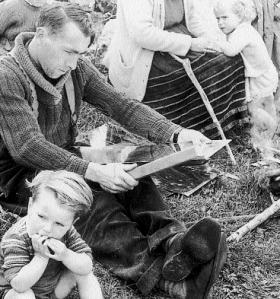
Tinsmith Bernard Mongan making a tin can at a Traveller encampment, Cahermorris, Co. Galway, c. 1960s. Note the uniquely Traveller apron worn by the woman on the right. (National Museum of Ireland)
Significantly, neither McCarthy nor the Gmelches reiterate the popular myth of descent from Irish nobility, nor that of continuity with Gypsies elsewhere, but the latter introduce an entirely new one: ‘Personal problems, such as illegitimacy or alcoholism, sometimes forced an individual or family into itinerancy’. Note that all of these options stipulate harsh circumstances forcing nomadism onto essentially sedentary people, with the innovative twist that this may be due as much to individual inadequacy as to outside forces: some tinkers have (literally) fallen by the wayside through their own fault. They are damaged goods.
My objection to the ‘drop-out’ theory of Traveller origins is not that they and their culture would be worthless if it were true. The drop-out theory could be applied to the convict origins of white Australians, yet they’re thriving nonetheless. My objection to the drop-out theory in relation to Irish Travellers is not that it’s unpalatable but that it is demonstrably untrue and blatantly motivated by a political agenda: to justify their ‘re’-assimilation into mainstream Irish society. For example, George Gmelch’s Irish Tinkers: the urbanisation of an itinerant people (1977) concludes with two case-studies of ‘successful’ settlement—with the proviso that ‘ “Success” is used here as a relative term referring to the average length of home occupancy [this implies that a trailer is not a home] and the level of acceptance the housed families have attained into the settled community. Success isn’t just getting into a house and staying there, but fitting in—assimilating. Better yet, marrying a non-Traveller is ‘the ultimate sign of acceptance and integration’.
Mobile accommodation: a recent introduction?
Crucially, the Gmelches hold that, until the late nineteenth century, itinerants ‘had no shelter of their own: lodging was obtained in hay sheds or in the homes of peasants’; mostly, they claim, itinerants slept ‘on the roadside in the shelter of the hedgerows’. They state that the introduction of the tent—in the 1870s, by a Tinker who copied the idea from Gypsies he met in England—and the evolution of ‘an argot spoken only by itinerants’ copper-fastened their isolation from the general population from which they were drawn while increasing their interaction with each other. By this reckoning, distinctive Traveller identity (as opposed to mere lifestyle), forged from a ragbag of victims and drop-outs, was less than a century old at the time of writing.
It is this version that has become today’s conventional wisdom. It determines how non-Travellers define, and therefore also how they treat, Travellers—not just in day-to-day encounters but institutionally, in schools, employment, accommodation, social welfare, health care and all the rest of it. Worse again, Travellers themselves, constantly exposed to these convincing explanations of who they ‘really’ are, end up internalising them. Theory, conjecture and scholarship may start off in the ivory tower but do not remain there.
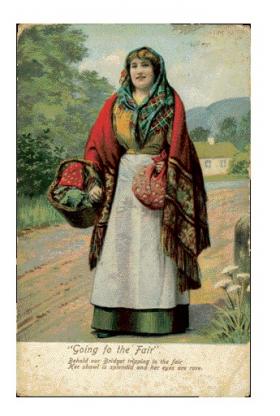
Original postcard (1957) sold to the author at the 2004 Gypsy Lore Society conference, Newcastle-on-Tyne, as portraying ‘an Irish tinker’.
The fundamental problem with existing versions of Irish Traveller history is that without exception they are written by people with no grasp of general Irish history. For example, the contention that tents were unknown here until the late nineteenth century holds no water at all. The National Gallery in Dublin exhibits early nineteenth-century Irish paintings of Traveller camps replete with tents and caravans, but we can go back a lot further than that. Any Irish schoolchild will tell you that Brian Ború was killed by Vikings in 1014 as he prayed in his tent. The epic Táin Bó Cuailgne, already ancient when written down half a millennium earlier again, includes references to the tents of Queen Maeve’s army. In fact, bent branches covered in skins, reeds, sods of earth, tarpaulin or sheets of plastic have been sheltering Irish people for at least 9,000 years, as the post-holes of nearly circular mobile dwellings at Mount Sandel, Co. Derry, attest. Assertions of sheltering in hedgerows—themselves an eighteenth-century development in Ireland, and rare west of the Shannon, where walls of unmortared stone predominate—notwithstanding, Ireland’s perpetually wet climate simply does not permit survival without shelter, and for the 3,000 years of human existence here prior to the introduction of farming that shelter was of necessity mobile.
Even after the introduction of farming (around 4000 BC) mobility, in the form of transhumant pastoralism, remained the cornerstone of the Irish economy until the localised imposition of feudal land use under the Anglo-Normans, from the late twelfth century. Irish people, up to and including the Celts, who arrived a mere five centuries BC, have always preferred low-density accommodation in extended family groups—the raths, duns, lisses and cashels that dominate any list of Irish place-names. But the use of metal in Ireland goes back four and a half millennia; the National Museum in Dublin houses bronze tools and weapons as well as stunningly wrought gold ornaments from 2500 BC onwards. The guides there will tell you that these objects were clearly produced by specialists, not farmers, and that until the growth of the monasteries from the sixth century AD (a mere 1,400 years ago) these specialists could not have been sedentary simply because there were no population centres to sustain them: in fact there were no towns in Ireland until the Vikings introduced the notion around the ninth century. Thus the idea of pre-Christian craftsmen adopting nomadism as a deviation from a sedentary norm is, in the Irish context, patently false.
The Gmelches assert that Travellers sheltered in haysheds, not structures commonly found in Ireland, where hay is stored in ricks, or in peasant homes, without considering how a family with up to a dozen children could possibly have fitted by the fireside of the already overcrowded average cottage. A night’s shelter was commonly extended to individuals—beggars, tailors, musicians—but there are no references whatever to sheltering families—except when a tinker woman would pose as a lone beggar in order to sneak her brood in when the household retired. The flipside of this porous boundary/hospitality theme, namely the assumption that Travellers welcomed alcoholics, ‘fallen women’, evicted peasants, etc. into their ranks, really expresses the notion that Travellers are essentially an anti-culture of drop-outs who embrace their fellow drop-outs—a bourgeois fantasy of running away with the tinkers as a variant on running away with the circus.
Tinker or Gypsy?
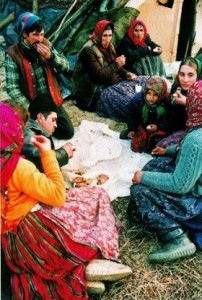
Romanian Roma camping under a bridge in Warsaw, Poland, in March 1994. Drop-out theorists contrast Irish Travellers with this ‘ancient, highly cultured race’ despite the fact that both are subject to identical stereotyping and discrimination from surrounding populations. (Piotr Wójcik)
The issue of who welcomed whom brings us to a common, and pervasive, problem in the interpretation of such historical sources as have been consulted. When looking at the past, it is sometimes assumed that all references to peripatetic trades are references to Travellers, despite the fact that most—weaving, for example, or tailoring, or thatching, all cited by the Gmelches—were practised seasonally by craftsmen whose dependants remained in a permanent base. Further back again, under the Gaelic order, professional bards—often assumed to be the precursors of the (Traveller) Ward family (Mac an Bhaird)—received land from their patrons and farmed it for most of the year, only shifting to professional poet mode in the agricultural off-season. The Gmelches back their drop-out theory by citing family histories featuring named individuals who went ‘on the road’ as a result of eviction or in pursuit of a trade, and now that I am researching Traveller family trees I too have come across such stories. Families traceably descended from non-Traveller stock do indeed exist, but they are a minority, usually associated with atypical trades, who bear distinctive surnames and tend to marry amongst themselves rather than with those families who see themselves as ‘traditional’ (i.e. as never having been anything other than Traveller), who have no such stories and whose ‘lack’ of explanatory history provides nothing to reproduce.
Such families associate themselves primarily with tinsmithing, which seems to offer continuity to the twelfth century when ‘tinker’ became a common surname, but again this tie-in is based on a total misunderstanding of Irish realities. For starters, the source is the Oxford English Dictionary; it was many centuries before the Irish—who did not commonly speak English until the eighteenth century—adopted surnames, and when they did these were typically of the ‘son of’ rather than the occupational variety favoured in England (Butcher, Baker, Thatcher, etc.); moreover, the Tinker surname has nowhere in these islands been associated with Travellers. In fact, the term ‘tinker’ was an occupational, not ethnic, description, a generic synonym for ‘nomadic tinsmith’. When the Gypsy Lore Society was founded in Liverpool in 1881 the first few issues of its journal carried articles on Belgian, Italian and Swiss tinkers and even speculated as to whether ‘oriental tinkers’ were the ancestors of today’s Gypsies. As an increasingly dichotomised vision of Indian-derived legitimacy versus indigenous bogusness took shape, the term came to mean ‘non-Romany Traveller’, gradually narrowing its focus to British, then Celtic, then specifically Irish Travellers, in which context it was assigned a spurious Gaelic etymology of tin + ceard, supposedly the Irish for ‘smith’, which is in fact gabha. The Irish for tin is stán, the root of stánadóir, tinsmith—a word never collectively applied to Travellers, who are known as an Lucht Siúil, literally ‘the walking people’; the word tincéir is, like búistéir and báicéir (butcher and baker), derived from English and not vice versa. As it happens, exploitable tin is not even found in Ireland (though it is in Britain) and did not displace wood and clay here until the eighteenth century. For all of these reasons, British references to ‘tinkers’ prior to the late nineteenth century cannot be assumed to cover Irish Travellers. Nor indeed should Irish references to ‘Gipsies’ be assumed to exclude them; in colloquial speech all over Ireland the term continues to be applied to Travellers, just as it was by respondents to the Folklore Commission questionnaire. Just to confuse matters, historical sources confirm an ‘Egyptian’ (Gypsy) presence in Ireland from four centuries before that. That the two are blurred in popular perception—have another look at the ‘gipsy’ references in Joyce’s Ulysses—indicates that they are, at the very least, deemed to have a great deal in common.
Even this brief coverage shows that the so-called ‘Travelling community’ in Ireland comprises a number of quite distinct groups, including ‘traditional’ families, relatively new recruits, and long-established Romany speakers. But—and this is the overriding flaw in Traveller research, and not confined to Ireland—this internal diversity is never recognised. Any local Traveller population, or Traveller family, or even individual Traveller, is deemed representative of all, and thus a valid basis for sweeping generalisations. Crawford (Genetic affinities and origin of the Irish Tinkers, 1975) bases categorical statements about Traveller ‘genetics and origin’ on blood samples from just 127 Travellers; Ó Nualláin and Forde (Changing needs of Irish Travellers: health, education and social issues, 1992) present research carried out on 28 closely related, sedentary nuclear families in a single town—deliberately excluding both their mobile relatives and temporary neighbours—as an alarming overview of genetic problems among Travellers in general; and at the extreme end of generalisation, Sharon Gmelch (Nan, 1986) presents an extremely troubled individual from a family with strong ‘settled’ connections as encapsulating Traveller experience. Findings based on these tiny samplings are accepted at face value, especially when they offer ‘scientific’ back-up for existing convictions.
A grounded alternative is long overdue
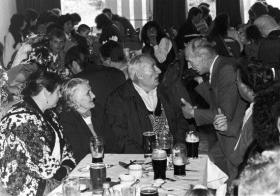
A Traveller wedding in Dublin in the 1980s—(l-r) Dinah Collins (née Joyce), Nan McDonagh (née Collins) and Paddy McDonagh. (Michael McDonagh)
For months I have been collecting demonstrably untrue statements about Traveller history (in fact assertions about Traveller legitimacy, or rather the lack of it) from a range of respected sources. I focus here on debunking those associated with the ‘drop-out theory’ of Traveller origins because they have had disproportionate influence, not only on popular perceptions in Ireland but also within international academia, summed up by Michael Stewart (The time of the Gypsies, 1977) as ‘In the past 150 years in Ireland, a population of Travellers has arisen from among the landless poor’, and even more succinctly by Marek Kohn (The race gallery: the return of racial science, 1995), who contrasts real Gypsies with ‘Irish Travellers, understood to be no more than an especially degraded strain of Irish people’.
No new orthodoxy is offered here in place of the old, but it is clear that the truths we thought we knew are lies, and lies that actively harm the people they’re told about. To date, circular logic has ensured that no qualified researchers have taken up the challenge of researching Traveller history, on the grounds that there isn’t any. We need scholars who can chase up, read and interpret original source materials, particularly in Irish (no one has done this so far). A grounded alternative to politically motivated statements about what Traveller history ‘must’ have been is long overdue.
Sinéad ní Shuinéar is a post-doctoral fellow of the Irish Research Council for the Humanities and Social Sciences, currently researching Traveller family histories.
*An earlier version of this article was delivered as a paper to the annual conference of the Gypsy Lore Society, Newcastle-on-Tyne, 3–4 September 2004. It is the result of prolonged dialogue between the author and Traveller activist Michael McDonagh.
Further reading
J. Helleiner, Irish Travellers: racism and the politics of culture (Toronto, 2000).
J. Kirk and D.P. Ó Baoill (eds), Travellers and their language (Belfast, 2002).
M. McCann, S. Ó Síochain and J. Ruane (eds), Irish Travellers, culture and ethnicity(Belfast, 1994).
S. ní Shuinéar, ‘Othering the Irish (Travellers)’, in R. Lentin and R. McVeigh (eds),Racism and anti-racism in Ireland (Belfast, 2002).
















